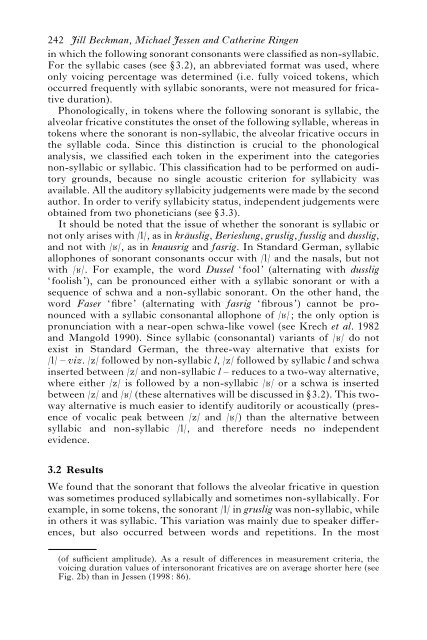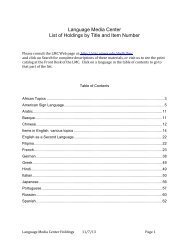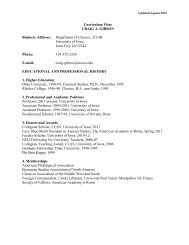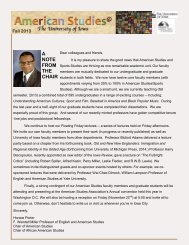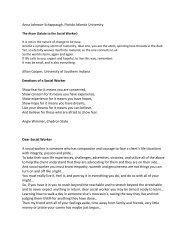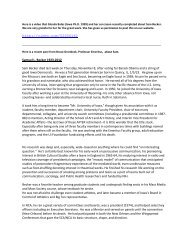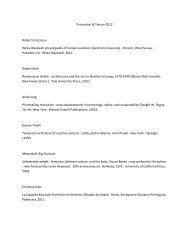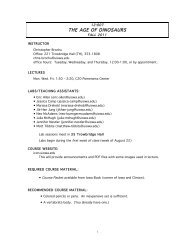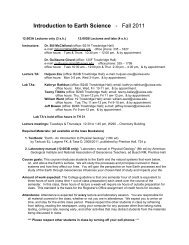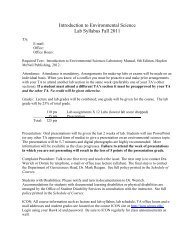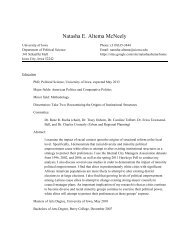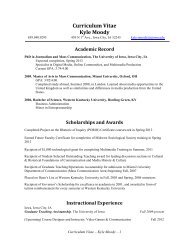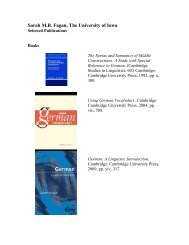German fricatives: coda devoicing or positional faithfulness?
German fricatives: coda devoicing or positional faithfulness?
German fricatives: coda devoicing or positional faithfulness?
You also want an ePaper? Increase the reach of your titles
YUMPU automatically turns print PDFs into web optimized ePapers that Google loves.
242 Jill Beckman, Michael Jessen and Catherine Ringen<br />
in which the following son<strong>or</strong>ant consonants were classified as non-syllabic.<br />
F<strong>or</strong> the syllabic cases (see w3.2), an abbreviated f<strong>or</strong>mat was used, where<br />
only voicing percentage was determined (i.e. fully voiced tokens, which<br />
occurred frequently with syllabic son<strong>or</strong>ants, were not measured f<strong>or</strong> fricative<br />
duration).<br />
Phonologically, in tokens where the following son<strong>or</strong>ant is syllabic, the<br />
alveolar fricative constitutes the onset of the following syllable, whereas in<br />
tokens where the son<strong>or</strong>ant is non-syllabic, the alveolar fricative occurs in<br />
the syllable <strong>coda</strong>. Since this distinction is crucial to the phonological<br />
analysis, we classified each token in the experiment into the categ<strong>or</strong>ies<br />
non-syllabic <strong>or</strong> syllabic. This classification had to be perf<strong>or</strong>med on audit<strong>or</strong>y<br />
grounds, because no single acoustic criterion f<strong>or</strong> syllabicity was<br />
available. All the audit<strong>or</strong>y syllabicity judgements were made by the second<br />
auth<strong>or</strong>. In <strong>or</strong>der to verify syllabicity status, independent judgements were<br />
obtained from two phoneticians (see w3.3).<br />
It should be noted that the issue of whether the son<strong>or</strong>ant is syllabic <strong>or</strong><br />
not only arises with /l/, as in kräuslig, Berieslung, gruslig, fusslig and dusslig,<br />
and not with /H/, as in knausrig and fasrig. In Standard <strong>German</strong>, syllabic<br />
allophones of son<strong>or</strong>ant consonants occur with /l/ and the nasals, but not<br />
with /H/. F<strong>or</strong> example, the w<strong>or</strong>d Dussel ‘fool’ (alternating with dusslig<br />
‘foolish’), can be pronounced either with a syllabic son<strong>or</strong>ant <strong>or</strong> with a<br />
sequence of schwa and a non-syllabic son<strong>or</strong>ant. On the other hand, the<br />
w<strong>or</strong>d Faser ‘fibre’ (alternating with fasrig ‘fibrous’) cannot be pronounced<br />
with a syllabic consonantal allophone of /H/; the only option is<br />
pronunciation with a near-open schwa-like vowel (see Krech et al. 1982<br />
and Mangold 1990). Since syllabic (consonantal) variants of /H/ do not<br />
exist in Standard <strong>German</strong>, the three-way alternative that exists f<strong>or</strong><br />
/l/ – viz. /z/ followed by non-syllabic l, /z/ followed by syllabic l and schwa<br />
inserted between /z/ and non-syllabic l – reduces to a two-way alternative,<br />
where either /z/ is followed by a non-syllabic /H/ <strong>or</strong> a schwa is inserted<br />
between /z/ and /H/ (these alternatives will be discussed in w3.2). This twoway<br />
alternative is much easier to identify audit<strong>or</strong>ily <strong>or</strong> acoustically (presence<br />
of vocalic peak between /z/ and /H/) than the alternative between<br />
syllabic and non-syllabic /l/, and theref<strong>or</strong>e needs no independent<br />
evidence.<br />
3.2 Results<br />
We found that the son<strong>or</strong>ant that follows the alveolar fricative in question<br />
was sometimes produced syllabically and sometimes non-syllabically. F<strong>or</strong><br />
example, in some tokens, the son<strong>or</strong>ant /l/ in gruslig was non-syllabic, while<br />
in others it was syllabic. This variation was mainly due to speaker differences,<br />
but also occurred between w<strong>or</strong>ds and repetitions. In the most<br />
(of sufficient amplitude). As a result of differences in measurement criteria, the<br />
voicing duration values of interson<strong>or</strong>ant <strong>fricatives</strong> are on average sh<strong>or</strong>ter here (see<br />
Fig. 2b) than in Jessen (1998: 86).


